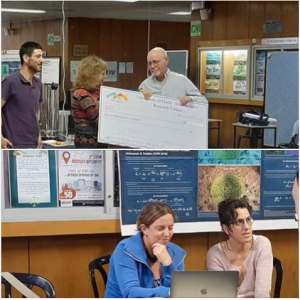Data Science and Sustainability
Speaker: Lior Greenspoony, The Department of Plant and Environmental Sciences, Weitzman Institute.
Title: The Global Biomass of Wild Mammals
Abstract:
Lior Greenspoon*1, Eyal Krieger*1, Yuval Rosenberg1, Yinon M. Bar-On1, Uri Moran1, Tomer Antman1, Shai Meiri2, Uri Roll3, Elad Noor1 and Ron Milo1
1Department of Plant and Environmental Sciences, Weizmann Institute of Science, Rehovot, Israel
2 School of Zoology & Steinhardt Museum of Natural History, Tel Aviv University, Israel
3 Department of Desert Ecology, Ben Gurion University of the Negev, Israel
Mammals are icons of conservation efforts, yet there is no rigorous estimate available for their global biomass. Biomass as a metric allows us to compare species with very different body sizes, and can serve as an indicator of wild mammal presence on a global scale. We compiled estimates of the total abundance of several hundred mammal species (i.e., the number of individuals) from the available data, and used these estimates to build a model that infers the total biomass of terrestrial mammal species for which the global abundance is unknown. Here, we present a thorough assessment, arriving at a total wet biomass of ≈26 million metric tons (≈26 Mt) for all terrestrial wild mammals, the equivalent of about 3 kg per person on earth. The primary contributor to the biomass of wild land mammals is the white-tailed deer, followed by the wild boar, African elephant and eastern grey kangaroo. We find that even-hoofed mammals (such as deer and boars) represent ≈45% of the combined mass of terrestrial wild mammals. In addition, we estimate the total biomass of wild marine mammals at ≈47 Mt, with baleen whales comprising ≈60% of the mass of marine mammals. In order to put wild mammal biomass into perspective, we additionally estimate the remaining members of the class Mammalia. The total mammal biomass is dominated by livestock (≈630 Mt) and humans (≈390 Mt). This work is a provisional census of wild mammal biomass on Earth, and can serve as a benchmark for human impacts.
Speaker: Dr. Shlomit Sharoni, postdoc at the University of Haifa.
Title: Elucidating phytoplankton physiological performance in the ocean
Abstract:
Phytoplankton are unicellular, drifting microorganisms that form the base of the marine food web. Their activity contributes ~50% of the global annual net primary productivity. Phytoplankton growth depends on nutrient availability. However, nutrients in the marine environment are often scarce, particularly in the open ocean. Thus, a major open question is whether phytoplankton communities in the ocean mostly experience nutrient stress or are well adapted to prevailing conditions. These contrasting physiological states affect the elemental composition of phytoplankton cells. To differentiate between these two alternate scenarios, we thus used observational datasets on phytoplankton elemental ratios and a model of phytoplankton physiology. We find that on average, phytoplankton are well adapted to their environment, even in nutrient poor regions, likely due of recurrent selection of the most fitted genotype. This mechanism involving shifts in phytoplankton communities likely sustains an effective flow of matter and energy through biogeochemical pathways.
—————————–
Lior Greenspoony, The Department of Plant and Environmental Sciences, Weitzman Institute.
Lior Greenspoon is a PhD student at Ron Milos’ lab the Weitzman Institute, at the Department of Plant and Environmental Sciences. Ron’s lab use a combination of computational and experimental synthetic biology tools to study the central carbon metabolism in quantitative terms.
In her undergraduate studies Lior majored in CS and Geology. She is using DS methods to study ecological questions.
—————————–
Dr. Shlomit Sharoni, postdoc at the University of Haifa.
Dr. Shlomit Sharoni, postdoc at the University of Haifa, working with Yoav Lahan from Marine Biology and Tali Treibitz from the Dept. of Marine Technologies. She uses DS methods to study marine biology ecological questions. Shlomit holds a BSc in Chemistry from the Hebrew University. Her MSc and PhD are from the Weitzman Institute at the Department of Earth and Planetary Sciences, where she worked on Modeling Global Biogeochemical Cycles, Marine Biology and Ecology.



